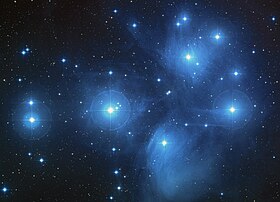| Observation data Epoch J2000 Equinox J2000 | |
|---|---|
| Constellation | Taurus |
| Right ascension | 03h 44m 52.53688s[1] |
| Declination | +24° 06′ 48.0112″[1] |
| Apparent magnitude (V) | 3.70[2] |
| Characteristics | |
| Spectral type | B6 IIIe[3] |
| U−B color index | -0.40[4] |
| B−V color index | -0.12[4] |
| Astrometry | |
| Radial velocity (Rv) | +10.9[5] km/s |
| Proper motion (μ) | RA: +20.84[1] mas/yr Dec.: −46.06[1] mas/yr |
| Parallax (π) | 8.06 ± 0.25 mas[1] |
| Distance | 400 ± 10 ly (124 ± 4 pc) |
| Absolute magnitude (MV) | −1.77[6] |
| Details | |
| Mass | 4.6-4.7[7] M☉ |
| Radius | 6.06+0.14 −0.15[8] R☉ |
| Luminosity | 940[8] L☉ |
| Surface gravity (log g) | 3.412±0.047[9] cgs |
| Temperature | 13,484±293[9] K |
| Rotational velocity (v sin i) | 181[9] km/s |
| Age | 115[10] Myr |
| Other designations | |
| Database references | |
| SIMBAD | data |
Electra /əˈlɛktrə/,[11] designated 17 Tauri, is a blue-white giant star in the constellation of Taurus located approximately 400 light years away. It is the third-brightest star in the Pleiades open star cluster (M45), visible to the naked eye with an apparent magnitude of 3.7. Like the other bright stars of the Pleiades, it is named for one of the Seven Sisters of Greek mythology.
- ^ a b c d e Van Leeuwen, F. (2007). "Validation of the new Hipparcos reduction". Astronomy and Astrophysics. 474 (2): 653–664. arXiv:0708.1752. Bibcode:2007A&A...474..653V. doi:10.1051/0004-6361:20078357. S2CID 18759600.
- ^ Ducati, J. R (2002). "VizieR Online Data Catalog: Catalogue of Stellar Photometry in Johnson's 11-color system". CDS/ADC Collection of Electronic Catalogues. 2237. Bibcode:2002yCat.2237....0D.
- ^ Cite error: The named reference
apj339was invoked but never defined (see the help page). - ^ a b Johnson, H. L.; Iriarte, B.; Mitchell, R. I.; Wisniewskj, W. Z. (1966). "UBVRIJKL photometry of the bright stars". Communications of the Lunar and Planetary Laboratory. 4: 99–110. Bibcode:1966CoLPL...4...99J.
- ^ Pearce, J. A.; Hill, G. (1975). "A spectroscopic investigation of the Pleiades". Publications of the Dominion Astrophysical Observatory. 14 (14): 319–343. Bibcode:1975PDAO...14..319P.
- ^ Zhang, P; Liu, C. Q; Chen, P. S (2006). "Absolute Magnitudes of Be Stars Based on Hipparcos Parallaxes". Astrophysics and Space Science. 306 (3): 113. Bibcode:2006Ap&SS.306..113Z. doi:10.1007/s10509-006-9173-1. S2CID 122897957.
- ^ Cite error: The named reference
zorecwas invoked but never defined (see the help page). - ^ a b Harmanec, P (2000). "Physical Properties and Evolutionary Stage of Be Stars". The be Phenomenon in Early-Type Stars. 214: 13. Bibcode:2000ASPC..214...13H.
- ^ a b c Frémat, Y.; Zorec, J.; Hubert, A.-M.; Floquet, M. (September 2005). "Effects of gravitational darkening on the determination of fundamental parameters in fast-rotating B-type stars". Astronomy and Astrophysics. 440 (1): 305–320. arXiv:astro-ph/0503381. Bibcode:2005A&A...440..305F. doi:10.1051/0004-6361:20042229. S2CID 19016751.
- ^ Basri, Gibor; Marcy, Geoffrey W.; Graham, James R. (1996). "Lithium in Brown Dwarf Candidates: The Mass and Age of the Faintest Pleiades Stars". The Astrophysical Journal. 458: 600–609. Bibcode:1996ApJ...458..600B. doi:10.1086/176842.
- ^ "Electra". Oxford English Dictionary (Online ed.). Oxford University Press. (Subscription or participating institution membership required.)
